Applications from the cloud
The software usage pattern is changing rapidly. “The cloudy future has already arrived. By 2025, 95% of IT spending will move from office equipment to the clouds. ” "The traditional model of using IT (directly in the offices of the company) has exhausted its capabilities, and in the next 10 years most of the IT operations will be transferred to the clouds." Such forecasts are heard in the last couple of years at industry conferences.
According to Gartner, in 2016 the global market for public cloud services will reach $ 204 billion, an increase of 16.5% compared with the previous year. At the same time, revenues from cloud applications, or SaaS services, will amount to 18.5% of this volume ($ 37.7 billion), which corresponds to an increase of 20.3% compared to the level of the previous year.
In the cloud computing market, the SaaS segment is most famous, in part because it has the largest number of users: many have experience working directly with cloud applications. Today, every Internet user deals with SaaS quite regularly: all online mail services, Google Docs, Microsoft Live, Office 365 and much more - all this is SaaS. A similar model applies to business applications.
')

SaaS (Software-as-a-Service) or “software as a service” means that the software manufacturer (software) allows you to use your application and charges a subscription fee. That is, the customer (user) does not buy software, but rents it for a period of time. The SaaS model now offers a variety of different software solutions, ranging from regular text editors to CRM and ERP systems and cloud PBXs. Corporate mail on Gmail, Yandex or other clients is the most massive example of SaaS. At the same time, SaaS does not limit the software capabilities, but simply uses a different economic model.

SaaS is one of the three main types of cloud services.
Today, to do business with minimal initial investment, you can organize an “office in the cloud” and choose the best set of services. The use of cloud resources allows you to reduce investment costs for the purchase of software, server or telecommunications equipment, and even completely abandon its own IT department and its maintenance costs, shifting the concern for supporting employees' workplaces and updating corporate software to the provider.

IT giants are changing the business model.
Focusing on the needs of the market, software manufacturers are gradually changing their business models and moving from selling stand-alone licensed software to renting public cloud services.
How does the SaaS application differ from the “usual” and what are its advantages, the benefit for the buyer? First of all, the payment mechanism. Such software is paid monthly in the form of a monthly fee, or by other criteria. In the case of SaaS, customers do not pay for the license, but for the rental of software, which eliminates the need to immediately invest heavily in the purchase of applications - the payment stretches over time. The monthly subscription model allows not only to reduce the initial investment, but also to use IT budgets flexibly and efficiently in the future. If the need to use the software is temporarily gone, then you can stop using it and no longer pay the developer or application provider.
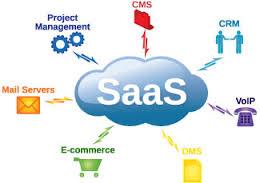
For example, in a few months the business results will disappoint you, or you will find the best application, then you simply stop renting the software, saving on the fact that you did not pay for its full cost. However, if it suits you, then over time the cost of renting may exceed the cost of buying a software license.

Sales of SaaS applications and traditional software in the world in recent years. The share of SaaS is still small, but it is gradually growing.
The main difference between SaaS and application hosting is the initial focus of the software on using this particular model. In most cases, application hosting is a special case of using traditional software, when the server side of the application is deployed at the hosting provider site. In this case, each customer is provided with a dedicated copy of the software in the data center of the provider.
SaaS, on the other hand, involves the use of a multi-tenant (multitenant) architecture, which requires a single software environment and a common hardware platform. This architecture implies other technical approaches to solving issues of scaling and optimizing system performance.
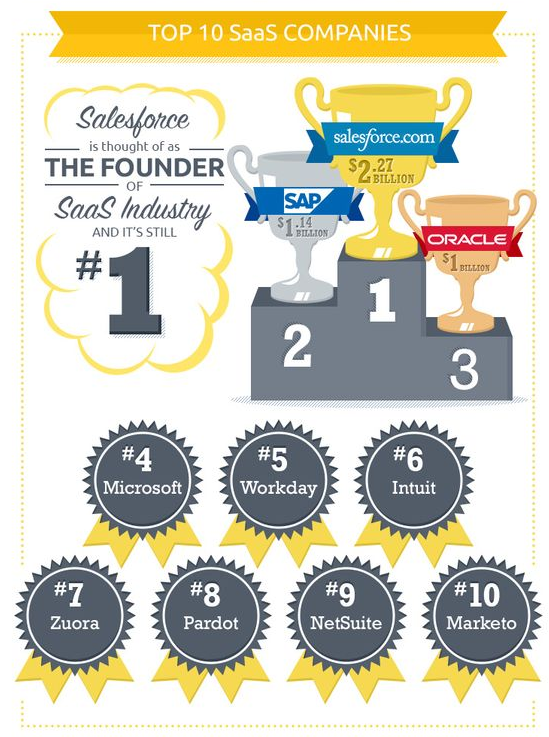
TOP-10 companies in the global SaaS market.
In addition, the SaaS application was originally designed for remote work and community use, and software support is already included in the board. One of the most significant advantages of the “software as a service” model is in the absence of the need for costs for installing, updating, and maintaining the servers and the software running on them. Using SaaS allows an employee not to become attached to a workplace or computer: access to the application is possible from anywhere with access to the Internet. Such a model is often called a “virtual office”. In the case of SaaS, you can get a hardware base (virtual server) from your hosting provider, and software.

Global SaaS market growth in billions of dollars
SaaS applications are affordable, you can quickly start to work and learn, they are focused on solving specific problems and allow you to quickly get results. A significant factor in favor of SaaS is growing confidence in cloud solutions as a whole.

The leaders of the global market for enterprise SaaS applications in terms of growth in the II quarter. 2016 (according to IDC).
With SaaS, there is no need to install software on employees' workplaces, since it is accessed via the Internet — through a regular browser. Software updates are transparent to users - the provider is responsible for this. There is no need to spend money on the administration of the security system.
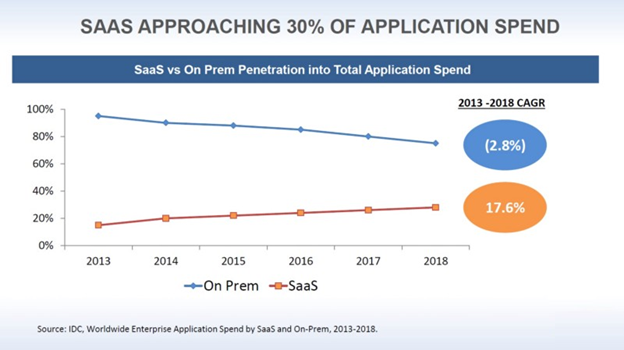 The share of spending on SaaS applications in the world is approaching 30% (according to IDC).
The share of spending on SaaS applications in the world is approaching 30% (according to IDC).
The main part of SaaS users is a small and medium business, for which the purchase of a software product and its subsequent support are quite expensive, therefore renting it is preferable. In addition, such a system will be beneficial for geographically distributed companies with a wide network of offices or branches, between which there should be a constant exchange of data, so large companies may be interested in SaaS. However, everything has its drawbacks.
What are the disadvantages and problems, what are the negative factors of “software as a service”? In Russia, there are frequent doubts about the safety and confidentiality of data. It is worth saying that cloud storage and applications are much more secure than the IT infrastructure of the companies themselves. However, the need to transfer commercial data to a third-party service provider is considered a negative factor in the use of SaaS.
SaaS (software as a service) is a software delivery model in which the platform developer provides all the technical support and daily operation of the service used by customers.
Specifications:
- Internet access
- Central control of the entire system
- One app - many users
Benefits:
- Accessibility from anywhere where there is Internet
- Fast start
- Technical support - the task of the supplier
- Lower cost
Disadvantages:
- Less flexibility and personalization
- Network only
One of the main conditions for the use of SaaS is a permanent and stable connection to the data source and software, that is, a reliable Internet channel. In the regions of Russia, this problem is often not resolved. “Bad Internet” is not very high speed of the system or applications, possible interruptions in access to software, and, as a result, interruptions in work. The speed of the system depends on the speed of the Internet connection.
However, all these problems are gradually fading into the background, since modern technologies make it possible to have stable and fast access to the Internet, and data encryption technologies reliably exchange commercial information. Therefore, SaaS systems are becoming more common.
SaaS is a key part of the cloud market. According to IDC forecasts, by 2018, 27.8% of the global corporate application market will be based on the SaaS model.
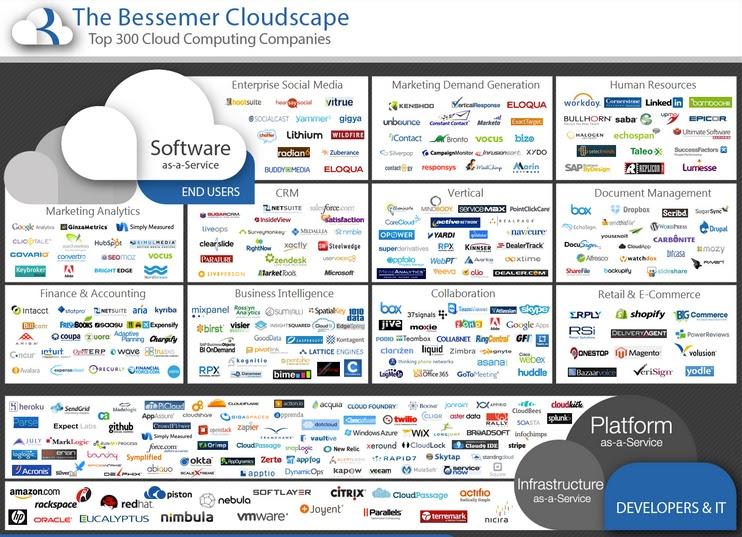
Cloud Atlas: leading vendors of different segments of the global cloud market.
The SaaS model is gradually becoming quite widespread in Russia. According to estimates of various analytical agencies, at present the growth of the Russian market of services offered by the SaaS model is ahead of the global one. According to the Parallels forecast, in 2016 the Russian market of services provided by the SaaS model in the small and medium business segment will reach 28 billion rubles.
In general, SaaS services have already become an everyday market offer and are quite familiar to users. According to a survey conducted by Naumen among Russian customers, 64% of respondents successfully work with a number of SaaS solutions, 19% plan to use SaaS, and 2% even transferred almost all corporate systems to the SaaS model, although 15% are still categorically against SaaS.
The growth of annual revenue of the largest SaaS suppliers in Russia is expressed in double digits. According to forecasts, until 2018, the growth rate of the SaaS market in the Russian Federation will be about 25%. The main reason - migration to SaaS allows you to optimize costs, which is especially important in a crisis.
Among the cloud services market as a whole, the SaaS market remains the largest segment. The share of SaaS in Russia in sales of "cloud solutions" is approaching 70%, and in the small and medium business segment is 90%. Such estimates are given by Parallels experts over the past few years. According to participants of the SaaS market, about two hundred quality services for business are represented on it, and about 30 IT companies form the main offers.
When using public cloud services, including SaaS, many companies and organizations choose local providers rather than a global provider. The reasons are different - these are the requirements of regulators, and the readiness of the local provider to tailor services to the requirements of the customer, and sometimes the best match between the services offered and the realities of the market and the consideration of regional features. In addition, products in Russian data centers are predictable pricing, independent of the exchange rate, higher speed of access to data in the cloud compared with foreign services.
In Russia, cloud providers actively offer analytical, financial and accounting applications, collaboration applications, CRM, e-commerce systems, and other solutions for the B2B segment.
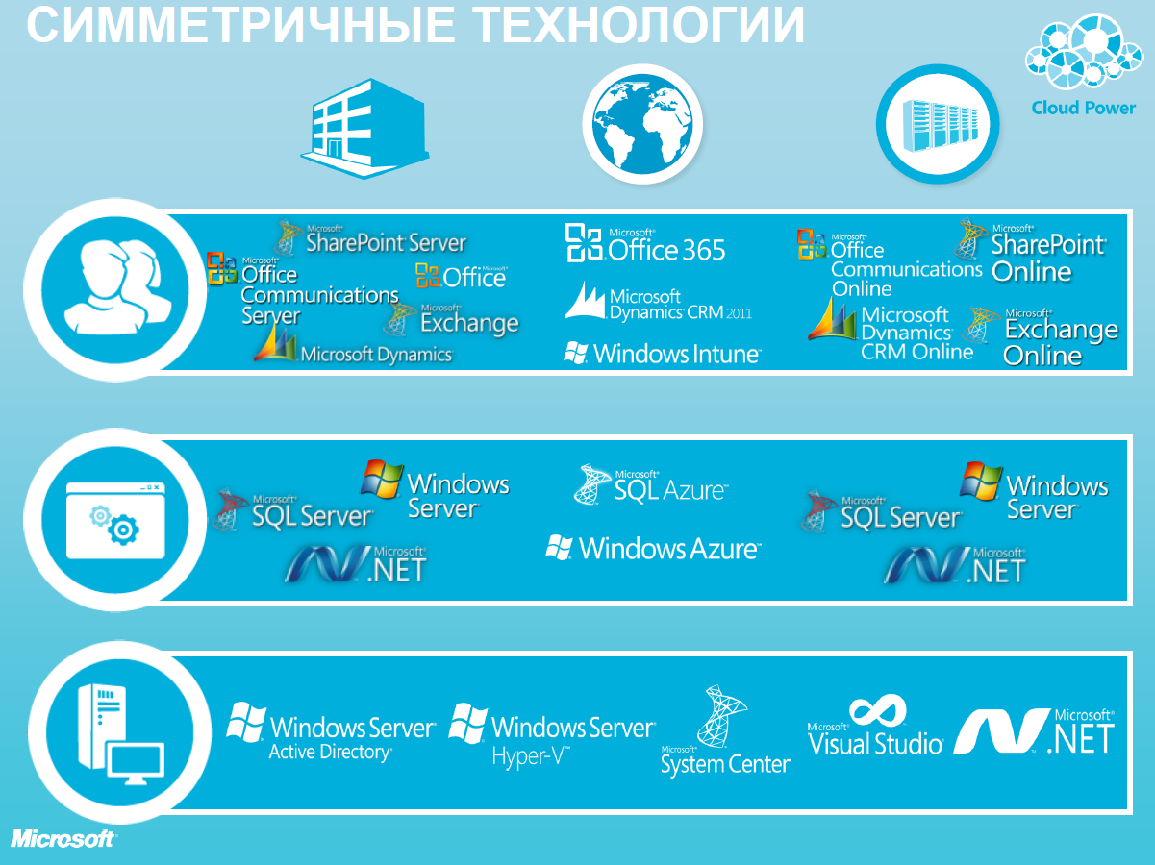 Microsoft offers both cloud and local versions of its software, developing both directions .
Microsoft offers both cloud and local versions of its software, developing both directions .
Popular offer - MS Office 365: office applications, business class email, communications and file management, corporate social network. It is found in many Russian cloud providers - Microsoft partners in the sale of cloud solutions.
Microsoft Office 365 makes it easier for enterprises to transition to cloud technologies by allowing IT managers to combine cloud and traditional technologies. To make this integration easier, Microsoft is investing huge amounts of money. Office 365 competes with Google Apps, although these are quite different products. Office 365 is a more functional, but also a more complex solution that is more suitable for medium and even large companies that are used to working in a Microsoft-oriented environment and have an administrator who understands Active Directory, the intricacies of Exchange and Sharepoint settings.
Russian providers of SaaS solutions offer their customers Microsoft cloud products under the Services Provider License Agreement (SPLA) program. This license agreement allows service providers and independent software developers to license Microsoft products and provide them to their customers as services.
This program is used by organizations whose activities are related to web hosting, renting (hosting) applications on the Microsoft platform, system integration, outsourcing of IT infrastructure and business processes, etc.
It provides several licensing options. A license type Subscriber Access License (SAL) is required for each user or device. In this case, in this licensing option, a separate server license is not required, and the subscriber can access any number of servers. A license like Processor License (PL) allows an unlimited number of users to access a product running on a given processor.
The SPLA program allows a partner to pay only for the software that was actually used by the end user at one time or another. Thus, SPLA helps to earn a partner and save the end user.
Having entered into a SPLA agreement, the partner company has the right to deploy the necessary Microsoft software and provide services to its customers on its basis. Paid software monthly. The advantages of the SPLA program are the absence of initial investments in software, flexible cost structure, stable prices, sales worldwide, etc.

SPLA program.
The hosting provider RUVDS in the framework of the partner program offers the opportunity to use “software as a service” for some software products, the list of which is constantly growing. The company is the official partner of Microsoft in the program SPLA. It leases dedicated virtual servers ( VPS / VDS) running modern licensed versions of Windows Server. The cost of each VDS / VPS server already includes a license for the operating system. Offered for rent and a range of related products.

RUVDS company offers related software for rent.
For example, renting a package of editors Microsoft Office - gives access to all employees working on the server, the ability to use a licensed package of office applications without extra costs for the purchase. Such product is licensed by the number of users.
If a team of employees works on a virtual server and you need to have more than two simultaneous connections to the VDS , you can use the RDS CAL service.
RDS CAL (Remote Desktop Services Client Access License) is a license that gives a user the right to access server services.
There are two types of Windows Server 2012 Remote Desktop Services CAL: Device CAL and User CAL. You can simultaneously use both types of client licenses to access the server software.
The Windows Server 2012 Remote Desktop Services External Connector license allows you to provide an unlimited number of external users (partners and customers) access to the remote desktop services based on Windows Server 2012.
One example of using MS SharePoint Server is creating a site that gives users the opportunity to work as a team. Sites created on the SharePoint platform can be used as a data warehouse, as well as used to execute web applications that facilitate interaction, such as wikis and blogs.
There are also various rental options for MS SQL Server . You can purchase a license for one user, or license the server core, without limiting the number of users.
According to Gartner, in 2016 the global market for public cloud services will reach $ 204 billion, an increase of 16.5% compared with the previous year. At the same time, revenues from cloud applications, or SaaS services, will amount to 18.5% of this volume ($ 37.7 billion), which corresponds to an increase of 20.3% compared to the level of the previous year.
In the cloud computing market, the SaaS segment is most famous, in part because it has the largest number of users: many have experience working directly with cloud applications. Today, every Internet user deals with SaaS quite regularly: all online mail services, Google Docs, Microsoft Live, Office 365 and much more - all this is SaaS. A similar model applies to business applications.
')

SaaS (Software-as-a-Service) or “software as a service” means that the software manufacturer (software) allows you to use your application and charges a subscription fee. That is, the customer (user) does not buy software, but rents it for a period of time. The SaaS model now offers a variety of different software solutions, ranging from regular text editors to CRM and ERP systems and cloud PBXs. Corporate mail on Gmail, Yandex or other clients is the most massive example of SaaS. At the same time, SaaS does not limit the software capabilities, but simply uses a different economic model.

SaaS is one of the three main types of cloud services.
Today, to do business with minimal initial investment, you can organize an “office in the cloud” and choose the best set of services. The use of cloud resources allows you to reduce investment costs for the purchase of software, server or telecommunications equipment, and even completely abandon its own IT department and its maintenance costs, shifting the concern for supporting employees' workplaces and updating corporate software to the provider.

IT giants are changing the business model.
Focusing on the needs of the market, software manufacturers are gradually changing their business models and moving from selling stand-alone licensed software to renting public cloud services.
RuVDSDaults of SaaS model from the model of using conventional software
How does the SaaS application differ from the “usual” and what are its advantages, the benefit for the buyer? First of all, the payment mechanism. Such software is paid monthly in the form of a monthly fee, or by other criteria. In the case of SaaS, customers do not pay for the license, but for the rental of software, which eliminates the need to immediately invest heavily in the purchase of applications - the payment stretches over time. The monthly subscription model allows not only to reduce the initial investment, but also to use IT budgets flexibly and efficiently in the future. If the need to use the software is temporarily gone, then you can stop using it and no longer pay the developer or application provider.

For example, in a few months the business results will disappoint you, or you will find the best application, then you simply stop renting the software, saving on the fact that you did not pay for its full cost. However, if it suits you, then over time the cost of renting may exceed the cost of buying a software license.

Sales of SaaS applications and traditional software in the world in recent years. The share of SaaS is still small, but it is gradually growing.
The main difference between SaaS and application hosting is the initial focus of the software on using this particular model. In most cases, application hosting is a special case of using traditional software, when the server side of the application is deployed at the hosting provider site. In this case, each customer is provided with a dedicated copy of the software in the data center of the provider.
| The main advantages of SaaS over traditional software: 1. Lower cost of ownership. 2. Shorter implementation time. 3. Low entry threshold (you can quickly and free to test). 4. Tasks for maintaining and updating the system completely fall on the provider. 5. User mobility, limited only by Internet access. 6. Support for geographically distributed companies and remote employees. 7. Low power requirements of the user's computer. 8. Cross-platform. |
SaaS, on the other hand, involves the use of a multi-tenant (multitenant) architecture, which requires a single software environment and a common hardware platform. This architecture implies other technical approaches to solving issues of scaling and optimizing system performance.

TOP-10 companies in the global SaaS market.
In addition, the SaaS application was originally designed for remote work and community use, and software support is already included in the board. One of the most significant advantages of the “software as a service” model is in the absence of the need for costs for installing, updating, and maintaining the servers and the software running on them. Using SaaS allows an employee not to become attached to a workplace or computer: access to the application is possible from anywhere with access to the Internet. Such a model is often called a “virtual office”. In the case of SaaS, you can get a hardware base (virtual server) from your hosting provider, and software.

Global SaaS market growth in billions of dollars
SaaS applications are affordable, you can quickly start to work and learn, they are focused on solving specific problems and allow you to quickly get results. A significant factor in favor of SaaS is growing confidence in cloud solutions as a whole.

The leaders of the global market for enterprise SaaS applications in terms of growth in the II quarter. 2016 (according to IDC).
With SaaS, there is no need to install software on employees' workplaces, since it is accessed via the Internet — through a regular browser. Software updates are transparent to users - the provider is responsible for this. There is no need to spend money on the administration of the security system.

The main part of SaaS users is a small and medium business, for which the purchase of a software product and its subsequent support are quite expensive, therefore renting it is preferable. In addition, such a system will be beneficial for geographically distributed companies with a wide network of offices or branches, between which there should be a constant exchange of data, so large companies may be interested in SaaS. However, everything has its drawbacks.
RuVDS Minuses SaaS
What are the disadvantages and problems, what are the negative factors of “software as a service”? In Russia, there are frequent doubts about the safety and confidentiality of data. It is worth saying that cloud storage and applications are much more secure than the IT infrastructure of the companies themselves. However, the need to transfer commercial data to a third-party service provider is considered a negative factor in the use of SaaS.
SaaS (software as a service) is a software delivery model in which the platform developer provides all the technical support and daily operation of the service used by customers.
Specifications:
- Internet access
- Central control of the entire system
- One app - many users
Benefits:
- Accessibility from anywhere where there is Internet
- Fast start
- Technical support - the task of the supplier
- Lower cost
Disadvantages:
- Less flexibility and personalization
- Network only
One of the main conditions for the use of SaaS is a permanent and stable connection to the data source and software, that is, a reliable Internet channel. In the regions of Russia, this problem is often not resolved. “Bad Internet” is not very high speed of the system or applications, possible interruptions in access to software, and, as a result, interruptions in work. The speed of the system depends on the speed of the Internet connection.
However, all these problems are gradually fading into the background, since modern technologies make it possible to have stable and fast access to the Internet, and data encryption technologies reliably exchange commercial information. Therefore, SaaS systems are becoming more common.
RuVDSSaaS in Russia
SaaS is a key part of the cloud market. According to IDC forecasts, by 2018, 27.8% of the global corporate application market will be based on the SaaS model.

Cloud Atlas: leading vendors of different segments of the global cloud market.
The SaaS model is gradually becoming quite widespread in Russia. According to estimates of various analytical agencies, at present the growth of the Russian market of services offered by the SaaS model is ahead of the global one. According to the Parallels forecast, in 2016 the Russian market of services provided by the SaaS model in the small and medium business segment will reach 28 billion rubles.
In general, SaaS services have already become an everyday market offer and are quite familiar to users. According to a survey conducted by Naumen among Russian customers, 64% of respondents successfully work with a number of SaaS solutions, 19% plan to use SaaS, and 2% even transferred almost all corporate systems to the SaaS model, although 15% are still categorically against SaaS.
The growth of annual revenue of the largest SaaS suppliers in Russia is expressed in double digits. According to forecasts, until 2018, the growth rate of the SaaS market in the Russian Federation will be about 25%. The main reason - migration to SaaS allows you to optimize costs, which is especially important in a crisis.
Among the cloud services market as a whole, the SaaS market remains the largest segment. The share of SaaS in Russia in sales of "cloud solutions" is approaching 70%, and in the small and medium business segment is 90%. Such estimates are given by Parallels experts over the past few years. According to participants of the SaaS market, about two hundred quality services for business are represented on it, and about 30 IT companies form the main offers.
RuVDS SPLA program
When using public cloud services, including SaaS, many companies and organizations choose local providers rather than a global provider. The reasons are different - these are the requirements of regulators, and the readiness of the local provider to tailor services to the requirements of the customer, and sometimes the best match between the services offered and the realities of the market and the consideration of regional features. In addition, products in Russian data centers are predictable pricing, independent of the exchange rate, higher speed of access to data in the cloud compared with foreign services.
In Russia, cloud providers actively offer analytical, financial and accounting applications, collaboration applications, CRM, e-commerce systems, and other solutions for the B2B segment.

Popular offer - MS Office 365: office applications, business class email, communications and file management, corporate social network. It is found in many Russian cloud providers - Microsoft partners in the sale of cloud solutions.
Microsoft Office 365 makes it easier for enterprises to transition to cloud technologies by allowing IT managers to combine cloud and traditional technologies. To make this integration easier, Microsoft is investing huge amounts of money. Office 365 competes with Google Apps, although these are quite different products. Office 365 is a more functional, but also a more complex solution that is more suitable for medium and even large companies that are used to working in a Microsoft-oriented environment and have an administrator who understands Active Directory, the intricacies of Exchange and Sharepoint settings.
Russian providers of SaaS solutions offer their customers Microsoft cloud products under the Services Provider License Agreement (SPLA) program. This license agreement allows service providers and independent software developers to license Microsoft products and provide them to their customers as services.
This program is used by organizations whose activities are related to web hosting, renting (hosting) applications on the Microsoft platform, system integration, outsourcing of IT infrastructure and business processes, etc.
It provides several licensing options. A license type Subscriber Access License (SAL) is required for each user or device. In this case, in this licensing option, a separate server license is not required, and the subscriber can access any number of servers. A license like Processor License (PL) allows an unlimited number of users to access a product running on a given processor.
The SPLA program allows a partner to pay only for the software that was actually used by the end user at one time or another. Thus, SPLA helps to earn a partner and save the end user.
Having entered into a SPLA agreement, the partner company has the right to deploy the necessary Microsoft software and provide services to its customers on its basis. Paid software monthly. The advantages of the SPLA program are the absence of initial investments in software, flexible cost structure, stable prices, sales worldwide, etc.

SPLA program.
The hosting provider RUVDS in the framework of the partner program offers the opportunity to use “software as a service” for some software products, the list of which is constantly growing. The company is the official partner of Microsoft in the program SPLA. It leases dedicated virtual servers ( VPS / VDS) running modern licensed versions of Windows Server. The cost of each VDS / VPS server already includes a license for the operating system. Offered for rent and a range of related products.

RUVDS company offers related software for rent.
For example, renting a package of editors Microsoft Office - gives access to all employees working on the server, the ability to use a licensed package of office applications without extra costs for the purchase. Such product is licensed by the number of users.
If a team of employees works on a virtual server and you need to have more than two simultaneous connections to the VDS , you can use the RDS CAL service.
RDS CAL (Remote Desktop Services Client Access License) is a license that gives a user the right to access server services.
There are two types of Windows Server 2012 Remote Desktop Services CAL: Device CAL and User CAL. You can simultaneously use both types of client licenses to access the server software.
The Windows Server 2012 Remote Desktop Services External Connector license allows you to provide an unlimited number of external users (partners and customers) access to the remote desktop services based on Windows Server 2012.
One example of using MS SharePoint Server is creating a site that gives users the opportunity to work as a team. Sites created on the SharePoint platform can be used as a data warehouse, as well as used to execute web applications that facilitate interaction, such as wikis and blogs.
There are also various rental options for MS SQL Server . You can purchase a license for one user, or license the server core, without limiting the number of users.
Source: https://habr.com/ru/post/313540/
All Articles